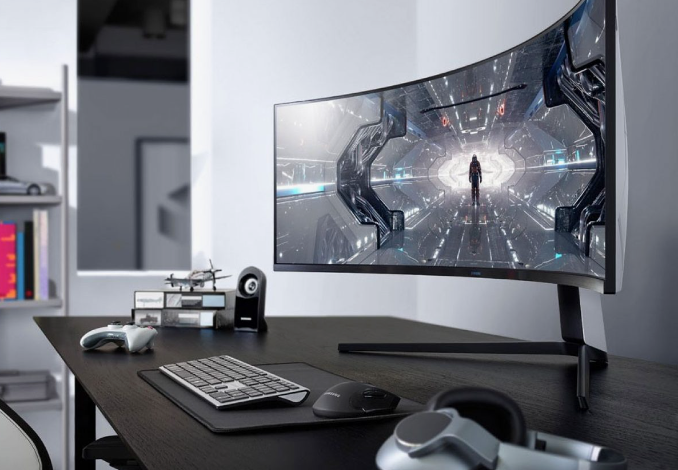How to Choose the Best Curved Gaming Monitor For Your Setup
How to Choose the Best Curved Gaming Monitor

Selecting a high-quality the best curved gaming monitor requires an understanding of different elements and components. It requires expertise in numerous key factors to ensure the screen you pick elevates your gaming experience to ultimate heights. Let’s delve into the factors you need to consider when choosing the best-curved screen for your setup.
Understanding Screen Curvature
The best-curved gaming PC screen involves understanding screen curvature. Knowing the curvature radius, denoted as “R,” influences your viewing experience. It involves acknowledging the R factor and optimizing size and distance. It also provides ultrawide aspect ratios as well.
The Concept of R and Its Impact
Curvature rankings are denoted as “R.”. You must measure the curvature radius of the best-curved gaming monitor. A smaller “R”-wide variety approaches a more stated curve. This specification immediately affects how immersive your gaming experience can be, with curvatures ranging from 1800R to 4000R. An 1800R curve guarantees an extra-engaging experience than a 4000R curve.
Optimal Size and Distance
Combining display size with curvature is crucial for an enhanced gaming experience. Larger monitors with a too-distributed curve cannot deliver the immersive experience you’re after, while a smaller display with a competitive curve should distort visuals. However, finding a balance based on your viewing distance complements the gaming experience.
Ultrawide Aspect Ratios
Curved monitors come in ultrawide component ratios, including 21:9 or 32:9, offering greater screen actual property. This prolonged width can drastically enhance the immersive experience in games that support ultrawide resolutions, offering a panoramic view and a competitive edge in dimensional awareness.
Consider your viewing angle.
The curve complements viewing angles, which is an essential component in maintaining consistent colors and brightness across the display screen. For gamers, this explains that regardless of how extreme the game gets, the display remains clear and vibrant.
Connectivity and Features
Connectivity and features on a curved gaming surface encompass the style of ports and added functionalities that enhance the user experience and versatility. It involves port selection, ergonomic adjustments, in-built speakers, and other capabilities.
Port Selection
Ensure the display has ample connectivity alternatives, such as HDMI and DisplayPort, to deal with your PC and some other gadgets you want to connect. USB ports are beneficial for easy access to peripherals.
Ergonomic Adjustments
An adjustable stand allows for better tilting, turning, and height adjustments and can considerably enhance consolation at some point in long gaming sessions. Some monitors also provide a turn for portrait orientation, which is useful for streamers or multitaskers.
Built-in Speakers and Other Extras
While integrated audio systems commonly don’t have healthy, committed sound systems, they’re convenient for informal use. Other functions include LED lighting for aesthetics, a built-in KVM switch for the use of more than one PC with one set of peripherals, and a curve that matches your eye’s herbal curvature for multiplied comfort.
Resolution and Panel Technology
Resolution and panel technology are pivotal in figuring out the visual quality and overall performance of a curved gaming screen. It includes better resolution choices, panel types, high refresh rates, and response times.
Resolution Choices
Higher resolution results in sharper graphics, but it also demands more from your graphics card. 4K is a popular alternative for curved monitors, 1080p, and 1440p. While 1080p can be sufficient for smaller displays, 1440p or 4K resolutions are best for video display units 27 inches and up. It helps in placing a balance between overall performance and photo quality.
Panel Types
IPS, VA, and TN panels all offer wonderful benefits. IPS panels excel in color accuracy and viewing angles, making them the best for gaming and content creation. VA panels provide better contrast ratios, providing deeper blacks and extra-vibrant shades. These capabilities make them ideal for immersive gaming. TN panels provide fewer reaction times and lag in color and viewing angles, making them less favorable for curved video display units.
Refresh rate and response time
A high refresh rate is very important for a smooth gaming experience, with 144 Hz being a sweet spot for many game enthusiasts. Meanwhile, a low response time reduces motion blur, enhancing the clarity of rapid-moving graphics. For competitive gaming, you can prioritize video display units with a minimum 144Hz refresh rate and a reaction time of 1 ms.
Aesthetics and Space Considerations
Aesthetics and area considerations play a crucial role in deciding on the proper curved gaming screen, as they ensure that the device performs well but also fits seamlessly into your gaming environment.
Design Match
The display must complement your gaming setup’s aesthetic. Many curved video display units offer smooth designs with skinny bezels and RGB lights. It helps enhance the overall appearance of your gaming setup.
Desk Space
Curved video display units can require a lot of table space, especially in ultrawide styles. Measure your table space to ensure the display will fit effectively, leaving sufficient room for peripherals and ensuring the curve doesn’t weigh down your space.
Wall Mounting
If the table area is confined, consider a screen that supports VESA mounting. This allows for wall mounting, releasing up table area, and supplying greater flexibility in positioning the reveal for the gold standard viewing experience.
Integrating into Your Setup
Think about how the monitor will combine with the rest of your setup. This includes not only bodily placement but also how it enhances different additives in terms of overall performance and aesthetics. A cohesive setup can enhance the overall gaming experience.
Conclusion
Choosing the curved gaming screen involves managing a balance among technical specs, non-public choices, and the physical area of your gaming area. By considering the curvature, decision, panel technology, connectivity, and aesthetics, you can pick out a display that not only meets your gaming desires but also turns into the centerpiece of your setup. Remember, the goal is to decorate your gaming experience, so prioritize features that contribute to immersion, consolation, and overall performance. With the proper curved display, you can rework your gaming periods into deeply engaging adventures.



